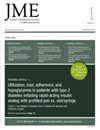利用患者层面的模拟模型,分析心房颤动一线或药物无效导管消融术和延迟二线导管消融术的临床和经济影响。
IF 2.9
4区 医学
Q2 HEALTH CARE SCIENCES & SERVICES
引用次数: 0
摘要
材料和方法使用患者级模拟模型,利用已发表的数据和专家意见模拟房颤患者的临床路径。不良事件(AEs)发生的概率取决于治疗和/或疾病状态。分析 1 比较了 0%、25%、50%、75% 或 100% 的患者接受一线消融治疗,其余患者接受 AADs 治疗的方案。在分析 2 中,比较了延迟 1 年或 2 年过渡到二线消融的影响。结果在 10 年内,将一线消融率从 0% 提高到 100%(与 AAD 治疗相比),两个国家的中风发生率降低了 12%,高频住院率降低了 29%,心脏复律率降低了 45%。随着一线消融率从 0% 增加到 100%,意大利每名患者的 10 年总费用从 13034 欧元增加到 14450 欧元,法国从 11944 欧元增加到 16942 欧元。在这两个国家,与 AAD 失败后延迟消融的方案相比,不延迟二线消融的方案发生的 AE 更少。提高一线或药物无效导管消融率以及缩短 AAT 会导致患者接受节律控制治疗的累积控制年数增加。局限性该模型包括基于现有最佳临床数据的假设,这些假设可能与现实世界的结果不同,但也包括敏感性分析,以消除参数的模糊性。结论在意大利和法国,增加一线或药物无效导管消融以及缩短 AAT 可提高房颤受控患者的比例并减少 AEs,从而抵消 10 年内房颤总成本所需的少量投资。本文章由计算机程序翻译,如有差异,请以英文原文为准。
Clinical and economic impact of first-line or drug-naïve catheter ablation and delayed second-line catheter ablation for atrial fibrillation using a patient-level simulation model.
AIMS
To determine the clinical and economic implications of first-line or drug-naïve catheter ablation compared to antiarrhythmic drugs (AADs), or shorter AADs-to-Ablation time (AAT) in atrial fibrillation (AF) patients in France and Italy, using a patient level-simulation model.
MATERIALS AND METHODS
A patient-level simulation model was used to simulate clinical pathways for AF patients using published data and expert opinion. The probabilities of adverse events (AEs) were dependent on treatment and/or disease status. Analysis 1 compared scenarios of treating 0%, 25%, 50%, 75% or 100% of patients with first-line ablation and the remainder with AADs. In Analysis 2, scenarios compared the impact of delaying transition to second-line ablation by 1 or 2 years.
RESULTS
Over 10 years, increasing first-line ablation from 0% to 100% (versus AAD treatment) decreased stroke by 12%, HF hospitalization by 29%, and cardioversions by 45% in both countries. As the rate of first-line ablation increased from 0% to 100%, the overall 10-year per-patient costs increased from €13,034 to €14,450 in Italy and from €11,944 to €16,942 in France. For both countries, the scenario with no delay in second-line ablation had fewer AEs compared to the scenarios where ablation was delayed after AAD failure. Increasing rates of first-line or drug-naïve catheter ablation, and shorter AAT, resulted in higher cumulative controlled patient years on rhythm control therapy.
LIMITATIONS
The model includes assumptions based on the best available clinical data, which may differ from real-world results, however, sensitivity analyses were included to combat parameter ambiguity. Additionally, the model represents a payer perspective and does not include societal costs, providing a conservative approach.
CONCLUSION
Increased first-line or drug-naïve catheter ablation, and shorter AAT, could increase the proportion of patients with controlled AF and reduce AEs, offsetting the small investment required in total AF costs over 10 years in Italy and France.
求助全文
通过发布文献求助,成功后即可免费获取论文全文。
去求助
来源期刊

Journal of Medical Economics
HEALTH CARE SCIENCES & SERVICES-MEDICINE, GENERAL & INTERNAL
CiteScore
4.50
自引率
4.20%
发文量
122
期刊介绍:
Journal of Medical Economics'' mission is to provide ethical, unbiased and rapid publication of quality content that is validated by rigorous peer review. The aim of Journal of Medical Economics is to serve the information needs of the pharmacoeconomics and healthcare research community, to help translate research advances into patient care and be a leader in transparency/disclosure by facilitating a collaborative and honest approach to publication.
Journal of Medical Economics publishes high-quality economic assessments of novel therapeutic and device interventions for an international audience
 求助内容:
求助内容: 应助结果提醒方式:
应助结果提醒方式:


